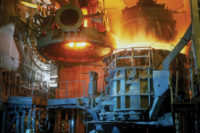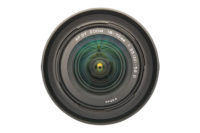It turns out that the hype about higher and even higher resolution security video is both real and unreal. The drums are now beating about 4K video but, according to end users and the experts, today’s megapixel sweet spot is 2 megapixels. It provides the image clarity, fits into many budgets and can work with most network infrastructures.
4K is not for widespread use in security, at least now. The cameras themselves carry a higher price tag than non-4K models, which is to be expected. And the infrastructure – network transmission and storage, for instance – needs to accommodate the increased load.
It’s like when 2-megapixel cameras were introduced. There are certain needs for it, and like any technology, the price is going to be high at first, says Scott Schafer, executive vice president of sales and marketing for Arecont Vision. But the performance is going to be incredible. The quality is amazing, and the frame rate is stellar.
Potential applications [for higher megapixels] include situations where end users need the ability to digitally zoom in on areas of a scene without losing the wider field of view; but there’s no reason 4K needs to be applied enterprise-wide, says Sean Murphy, regional marketing manager for video systems for Fairport, New York-based Bosch Security Systems Inc.
Upgrading to Megapixels
More common is use of megapixel cameras, for example, at Butler University, which has IP megapixel cameras for a surveillance upgrade for a variety of wide open spaces on campus.
Butler University is a liberal arts school situated in a residential area, five miles from downtown Indianapolis, Indiana. The university has an enrollment of approximately 4,500 students and offers more than 60 major academic fields of study in six colleges. Butler University’s 300 acre campus includes more than 30 buildings as well as a 20-acre garden, an observatory and water areas.
All universities today are looking for ways to improve physical security in order to provide a safer, more secure environment for students, faculty, staff and visitors. At Butler, the administration believed that upgrading their existing video surveillance to a fully digital IP system with high-resolution video surveillance cameras would help accomplish this goal.
The immediate need was to make improvements to the university’s outdoor coverage, and longer term to increase indoor surveillance. Accomplishing these objectives required the assistance of a knowledgeable system integrator – a partner who was experienced in providing IP megapixel solutions and a firm who could work hand-in-hand with multiple university stakeholders. For this, the university chose KST Security of Indianapolis.
Butler started the surveillance improvement project by evaluating various cameras and their capabilities to provide high quality images in an outdoor environment. The conclusion was that panoramic megapixel cameras (from Arecont Vision) delivered the best image details and, because of their 180° and 360° capability, would be the most cost-effective solution. The many additional features standard in the megapixel cameras, such as motion detection, true day/night functionality, wide dynamic range, vandal-resistant housings and remote focus/remote zoom, made the decision even easier.
Working with KST, school administrators next set out to develop and implement a deployment plan for the outdoor phase of the upgrade. As the project integrator, KST worked with Butler’s police and IT department personnel to ensure effective camera placements and integration with the existing exacqVision video management system (VMS) software.
Covering Diverse Areas
The decision to implement panoramic megapixel cameras provided immediate system improvements for the university. Not only did the cameras provide significant picture quality of high-traffic areas such as parking lots and student housing areas, but the cameras performed equally as well in the heavily wooded areas where walkways connect the main campus to the school’s athletic facilities.
The 180° and 360° cameras continuously capture a much wider field of view than other camera choices and the school receives complete coverage with fewer cameras overall.
The cameras use H.264 compression technology to reduce bandwidth over the school’s fiber and copper transmission system. Video is captured at full motion and full resolution without compromising image quality at any point in the process. The open standards-based cameras easily integrate with the VMS software.
“The improvement in the quality and performance of our video surveillance system with the megapixel cameras is incredible,” says Bill Weber, assistant chief of police, Butler University. “The 360-degree views have made a tremendous difference in providing a safer and more secure campus.” Based on the success of the outdoor camera installation, the school also installed panoramic megapixel cameras for indoor use.
Still, many enterprise users of security video have analog cameras, some with encoders and some with hybrid IP, as they move to a digital world. According to Dave Sweeney, chief operating officer at integration firm Advantech, there is no silver bullet when transitioning to digital and megapixel. Every customer’s applications and environment are different.
Sweeney points out that, while higher definition resolution is for specialty needs, he is installing 1080p 2-megapixel cameras for everyday use. It meets resolution, bandwidth and storage constraints. He adds that monitoring has come and somewhat gone. Now it is forensics, as enterprises check on incidents or evaluate data captured by the cameras. With IP and megapixel cameras, IT is now more involved as well as, in some cases, operations. Security can benefit from more budget when getting others involved.
Enter Analytics
The addition of analytics is the next evolution, contends Sweeney, who sees 4K at this time as the “bleeding edge” driven by marketing folks who seek something new to talk about. “Compression technology must improve to make sense of 4K.”
The biggest challenge regarding security video, its networking and integration capabilities is a lack of standards, says Sweeney. He points out that the Open Network Video Interface Forum (ONVIF) and the Physical Security Interoperability Alliance (PSIA) are both working on that issue.
Optics quality is important as well as lighting, says Charles McCready, senior product specialist at Panasonic. With the higher sophistication of chip sets, there are more than cameras functions. The cameras can do a lot more such as heat mapping, traffic patterns, people counting. And 360° cameras are playing a greater role, observes McCready, emphasizing the impact of cameras on a business beyond security.
Concerning 4K high definition, McCready believes that, for certain end users, “they will see the advantages and uses for the advanced technology.”
No doubt, the bottom line for megapixel cameras is quality and usefulness of the images for business purposes. Take for example, H.P. Cadwallader, which manufactures corrugated boxes, corrugated die cut packaging and related products. Its full line of product offerings are manufactured at the company’s 115,000 square foot facility, located in Harleysville, Pennsylvania.
In the fast paced and competitive world of manufacturing, companies can never stop improving their operations. H.P. Cadwallader had already updated its production facility with state of the art equipment to remain a leader in their target market. Even with the new equipment, increasing productivity and improving quality control was still on the radar as a goal.
To make further improvements, management reviewed operational procedures to look for areas where the process could be sped up or made more efficient.
The plant floor is large enough, and complex enough, that it is difficult for one or even two supervisors to have complete awareness of every process for quality control and safety purposes.
Production training was on-the-job, with little or no formal or prepared instruction materials.
Because the plant was running two shifts and operating almost 24 hours a day, it was difficult to determine who was authorized to be in the building and who was not, leading to security and safety vulnerabilities.
Finding a solution to these and other issues was a key management challenge. The review highlighted several areas of concern that could only be addressed with additional “eyes” on the scene and the best and most effective way to achieve this was through video monitoring. After meeting with Oliver Fire Protection and Security, management at H.P. Cadwallader realized there was opportunity for much more than just monitoring.
“Having high-quality recorded video of the printing process to show a client makes realizing customer satisfaction considerably more possible,” says Brooke Williams, president of H.P. Cadwallader. “It has also allowed for substantial cost savings because conflicts or concerns of any type by employees or clients can be resolved much more quickly with video evidence.”
Cost and Performance Count
The system is based on Samsung Techwin’s megapixel, full HD network cameras, with the video managed using an exacqVision video management system. The integrator recommended the solution because of cost and performance and the capability for system integration. To ensure adequate coverage of the facility and meet management’s need for production monitoring, a variety of cameras were installed, including fixed dome cameras; pan/tilt/zoom dome cameras; and 360° cameras. Additional cameras were later added to supplement coverage on the shop floor and in outdoor areas to monitor late night deliveries.
Among the benefits derived from the solution is the image quality provided by the cameras. Even in varying lighting conditions, the cameras deliver crisp images with clearly visible details. This has proven extremely useful in preventing costly errors because supervisors can watch for and detect potential problems before they happen and, if necessary can interrupt the process. The video from these incidents is also used for training purposes or the footage can be reviewed to provide evidence of an employee’s arrival or departure in the event they forgot to punch their time card. And while physical security was never a primary goal, motion detection and day/night functionality provided by the cameras alerts management to the presence of anyone in an unauthorized area.
The capability for remote viewing has also resulted in a significant benefit for management.
At any time, authorized personnel can view live or recorded images from anywhere they have an Internet connection. The pan/tilt/zoom cameras can be easily adjusted to provide further detail and information so that the necessary action can be taken. The 360° view camera provides a wide field of view for full situational awareness and the images it captures can be dewarped and/or displayed in a variety of view configurations, including single or double panorama, 360° view and more.
The most valuable benefit cited by management is the 20-percent increase in productivity, which they link to better supervision. Both supervisors and management have a new, more effective capability to assure efficiencies – a clear and constant view of activities on the shop floor, in the warehouse and at outdoor locations.
“Job safety is a primary goal at H.P. Cadwallader and, along with the increase in productivity; our workplace safety has also been improved with the implementation of the Samsung system,” adds Williams. “Employees are better trained on the equipment and supervisors react more quickly if/when they see something potentially dangerous.”
Going Beyond Security
Joel White, senior product manager for Tyco Security Products and who oversees the IP camera portfolio, concurs that megapixel cameras are no longer just for loss prevention. He sees the transition to high definition in critical locations and high-theft areas as well as some rip and replace installations. While agreeing that 1080p 2-megapixel surveillance is common these days, White says that you don’t have to go overboard in resolution. There’s cost of ownership and bandwidth. Enterprise security executives can pick from lowest price, middle tier and premium when it comes to megapixel cameras.
New York and New Jersey-area retailer Century 21's loss prevention (LP) department is headquartered at its flagship store in Manhattan, although each store maintains its own LP department and staff.
With each new store opening, Century 21’s loss prevention department looks to incorporate the latest technology to enhance the quality of its LP activities. The Jersey Gardens store, which opened in 2013 in an existing mall storefront, presented Century 21 with the opportunity to explore the transition to IP cameras from analog as well as discover additional features that could further reduce shrink as part of the company’s proactive LP program.
“We like to think we are a leader in technology and in pushing the envelope,” says James Betesh, vice president of loss prevention, Century 21 Department Stores. “As a 25-year customer with American Dynamics and Sensormatic, we trusted them to provide cutting-edge technology that would perform to our standards.” One specific challenge was how the company could address issues of latency that have been associated with some IP cameras. Latency is a delay between the movement of the joystick to command the camera and the camera’s response to the command.
Like most retailers that employ a team of active surveillance personnel to monitor their facilities, Century 21 was averse to delays in camera control that affected their ability to track and monitor situations in their stores in real-time.
Accurate Tracking
Instead, Century 21 chose IP PTZ dome cameras with very low latency for accurate camera tracking control, allowing Century 21’s surveillance staff to actively monitor activity in their stores. The camera moves to position as fast as 512 degrees per second, allowing for active surveillance and efficient tracking of suspicious behavior. “We have very proactive LP policies in place to protect our inventory and guest experience so we needed the lowest latency and best quality picture from these domes as possible,” Betesh says.
Converting from analog to IP would certainly be an investment, acknowledges Betesh; but he sees opportunities because the system can be used for more than just loss prevention. “There are a lot of additional returns on our investment in technology that are possible, such as tracking shopper behavior that can improve our guest experience,” he adds. By using active surveillance to track shopper movements, store operators can better position merchandise and displays, and staff their stores for both sales and security based on time-of-day analytics.
And while on-site staff members are making use of this type of analysis, Betesh says analytics can also be tied into the point of sale system and used by fraud investigators to detect issues at the cash registers.
Megapixel cameras also play a key role when it comes to potential theft.
Nestled in Starhill Gallery, Kuala Lumpur’s finest luxury retail, Mouawad jewelry boutique epitomizes exclusivity and fashion.
Mouawad’s managing director, Antoine Bakhache, who sees security as paramount, recognizes the importance and value of 360° video surveillance solution from Oncam. “I was literally taken in by the technology and the ease of use offered on the mobile app and knew immediately that this was the right technology for my business.”
The system improved situational awareness of the store while allowing the owner to effortlessly access remotely his surveillance system.
“Through the previous security video system, I was having difficulty being able to get a bird eye view of my store, especially when away,” Bakhache says. “Now I can quickly check any part of my store effortlessly, zoom in and rotate the view as much as I want, live and recorded. I never miss a thing.”
SIDEBAR: Will It be a Megapixel Body Camera?
Recently, Taser announced a large order for its Axon officer-worn camera system from the Louisville, Kentucky, Metro Police Department. The order includes 988 Axon Flex cameras and the Evidence.com evidence storage and management system. It also includes computer-aided design integration and Taser’s MediaSolv closed-circuit TV and photo management system.
In another move, answering calls to equip police officers with body cameras after a series of officer-involved deaths across the country, Illinois lawmakers, for instance, are pushing a plan to add a $5 fee onto traffic tickets to pay for the equipment while also setting statewide standards for how the cameras and the videos they capture could be used.
If enacted, Illinois would be the first state in the country to set statewide standards for the use of body cameras, Sims said.





